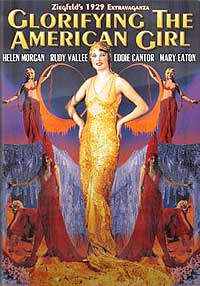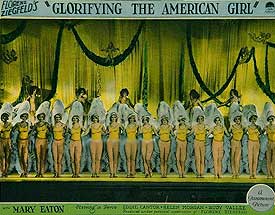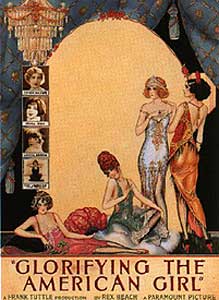 "A Pretty Girl is Like a Melody" opens the show with badly staged fashion show representing the March of Time from 1919 to 1928. We're tossed right into the main theme of Glorifying the American Girl (1928), that being the glorification of beauty.
"A Pretty Girl is Like a Melody" opens the show with badly staged fashion show representing the March of Time from 1919 to 1928. We're tossed right into the main theme of Glorifying the American Girl (1928), that being the glorification of beauty.
Mary Eaton as Gloria sings "No Foolin' (Who Do You Love)" & "Baby Face" at the music store where she works.
The film has been thus far a bit more primitive than average for the early sound films -- that is, until we reach the climax where all the budget was focused for startlingly gorgeous two-strip technicolor finale.
For decades if you could see this film at all, the two-color reels were faded or reduced to black & white, & the film shortened because of some pre-Code moments such as the illusion of nudity in the big art nouveau sequences at the end.
But it has at last been restored, & now thanks to the UCLA Film & Television Archive, we can really appreciate the last two reels as true treasures of cinema.
 It is also the only film for which scenes from an actual stage production of a Florenz Ziegfield production was filmed as-performed before live audiences, so that it becomes an important film for live theatrical history. It is also the only film for which scenes from an actual stage production of a Florenz Ziegfield production was filmed as-performed before live audiences, so that it becomes an important film for live theatrical history.
The ballet components of the big numbers at the end were choreographed by Ted Shawn, meaning the film is additionally significant for the history of American dance.
Alas for most viewers who would devour this film with glee, poor public domain prints are what one encounters on dvd, from cutrate distributors who delute the market for the restored film. The restored print (as I write this) has to be seen on non-profit museum screens or on campus screens or at UCLA itself.
In the meantimel, waiting for those last two reels, we have rather ordinary photography, but the cast is charming, & it's very interesting to see the music store setting. It was a type of business that would very soon be fading away, with records replacing the average home's music parlor with piano, & the sheet music stores supplanted by record stores. But before the advent of lacquer records, & the rise of the radio, music in the home was home-made, with a continuous public desire for sheet music of new tunes.
The success of a song was measured not in how many recordings were sold, but how many copies of the printed music. And those where days when a singer or a pianist could get ready shop employment while awaiting their Big Break as entertainers, daily giving customers the opportunity to hear the latest tune before buying a the sheet music.
 Gloria dreams of joining the Follies but is stuck making her minimum wage singing for the music store's clientelle. The store throws a company picnic, at which the act of "Miller & Mooney" perform. Gloria dreams of joining the Follies but is stuck making her minimum wage singing for the music store's clientelle. The store throws a company picnic, at which the act of "Miller & Mooney" perform.
Mooney's a girl who sings & dances. Miller's a guy who dances, jokes, sings. The act is very cute, especially when they sing "Spooning with the One You Love." But they don't get along with each other off stage, & Miller pretty much railroads the young woman (Kaye Renard) constantly assuring her he can always find another hoofer & call her Mooney.
When the woman opts out of the act, Gloria with no real connections & a lot of naivete hooks up with Danny Miller (Dan Healy) & becomes the new Mooney. Miller keeps her unaware that their twenty-day touring contract is more for her appeal than his.
Gloria's pursuit of her "name in lights" is a middlin' fair story of predictable dimensions, with a couple actual surprises, & unexpected villainies along the way. Danny hoodwinks Gloria into a five-year contract, so that when she finally realizes she's the one with the talent, he owns half of her whether he's in or out of the act.
Her boyfriend Buddy (Edward Crandall), a wannabe songwriter, is cast as a hero-type but is partly a terrible man who maltreats another woman, Barbara (Olive Gloria Shea), who loves him more than does Gloria. He's abusive to the gal whose love he has & adores the one who isn't honestly his.
 The real pay-off of the film isn't in Gloria, Buddy, Danny, or Barbara's romancings or vaudeville adventures, as what we get instead of a story resolution or character climax is a final pair of reels packed with performances. The real pay-off of the film isn't in Gloria, Buddy, Danny, or Barbara's romancings or vaudeville adventures, as what we get instead of a story resolution or character climax is a final pair of reels packed with performances.
As it's opening night, we get a series of cameos of famous people attending the performance, upping the number of famous names in the film without having to give them anything to do. We glimpse Noah Barry, Flo Ziegfield with his wife Billie Burke, Jimmy Walker, Adolph Zukor, Ring Lardner, plus others not so well remembered today.
Rudy Vallee pops up to sing "Vagabond Lover," one of the big hits of the 1920s. Rudy has naive charm though it's amazing to think how his minimal talent could've made him a true superstar for whom gals swooned.
Less contemporary to the '20s in her stylings but a big star of the time is Helen Morgan. With a rather surreal set she seems to be floating in space with a white piano, singing the Jay Gorney & e. Y. Harburg composition "What I Wouldn't Do For That Man." She's kind of awful, but the staging is thrilling.
 There's a long Eddie Cantor comedy skit that stops the music for a while. It's ethnic humor set in a clothing shop &am relies on stereotypes of Jews as crooks. There's a long Eddie Cantor comedy skit that stops the music for a while. It's ethnic humor set in a clothing shop &am relies on stereotypes of Jews as crooks.
Cantor had been a huge star in vaudeville & when he did these stereotypes for primarily Jewish audiences they went over differently. He was expected to become a big radio & movie comedian, so he was given a big section of the film to put on one of his more elaborate vaudeville playlets.
His act didn't go over as well in the melting pot milleau that was targetted by Hollywood Cinema. A giant of the Borsch belt would become a second-string performer the rest of his life, while every other Jewish commedian of merit from Jack Benny to Milton Berle skyrocketed past him, having found much more modern & intimate ways of being funny.
Gloria has a big dance number with lots of Ziegfield girls, singing "There Must Be Somebody Waiting for Me in Loveland." The Loveland sequence is amazingly pictorial, every moment like a Brandywine illustration or an art nouveau poster print.
The combination of jazz & ballet is experimentally bizarre in the best sense, & with Johnny Weissmuller turning up in his first film in the role of Adonis, the film ends up glorifying the beauty of the American boy as well as girl.
copyright © by Paghat the Ratgirl
|

